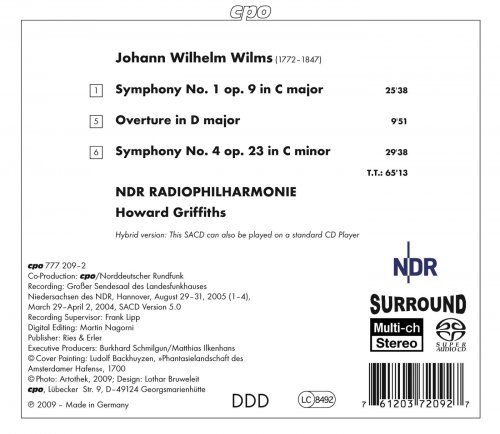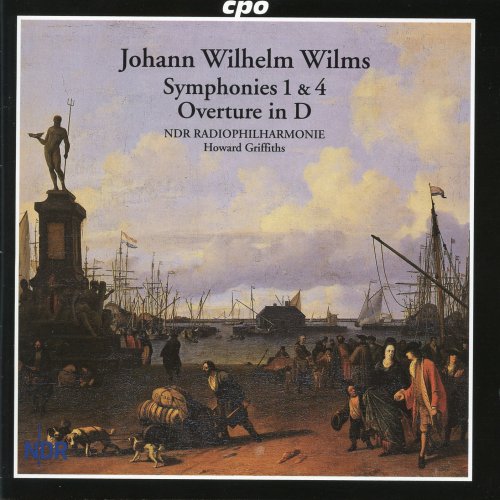
NDR Radiophilharmonie, Howard Griffiths - Wilms: Symphonies Nos. 1 & 4 - Overture in D (2009)
BAND/ARTIST: NDR Radiophilharmonie, Howard Griffiths
- Title: Wilms: Symphonies Nos. 1 & 4 - Overture in D
- Year Of Release: 2009
- Label: CPO
- Genre: Classical
- Quality: flac lossless (tracks) +Booklet
- Total Time: 01:05:13
- Total Size: 300 mb
- WebSite: Album Preview
Tracklist
01. Symphony No. 1 in C Major, Op. 9: I. Adagio-Allegro vivace
02. Symphony No. 1 in C Major, Op. 9: II. Andante
03. Symphony No. 1 in C Major, Op. 9: III. Menuetto: Allegro-Trio-Menuetto da capo
04. Symphony No. 1 in C Major, Op. 9: IV. Finale: Allegro
05. Overture in D Major
06. Symphonie a Grand Orchestre in C Minor, Op. 23: I. Adagio-Allegro non molto
07. Symphonie a Grand Orchestre in C Minor, Op. 23: II. Andante
08. Symphonie a Grand Orchestre in C Minor, Op. 23: III. Menuetto-Trio-Menuetto
09. Symphonie a Grand Orchestre in C Minor, Op. 23: IV. Rondo: Allegro

Conductor Howard Griffiths seems to be very excited leading the NDR Philharmonie in the photograph reproduced on the back of the booklet of this CPO release and perhaps he should be: this disc contains two premieres in a program of music by Johann Wilhelm Wilms. If that name doesn't make you jump from your seat, bear in mind that Wilms was the top Dutch composer of orchestral music in his day, although he picked a rather unfortunate era in which to thrive, that of the early romantic, alongside Ludwig van Beethoven. Moreover, Wilms' music - as noticed by contemporary reviews in the Allgemeine Musicalische Zeitung for which Wilms himself briefly served as the Amsterdam-based correspondent - is clearly influenced by the example of Beethoven from practically its first note. But Wilms was by no means a Beethoven imitator, but someone who carved out a strongly individual style of his own within the parameters of Beethoven's innovative sound, and by 1820, Wilms was the most frequently heard orchestral composer in the Netherlands. However, by 1830 and the advent of Berlioz's Symphonie Fantastique, Wilms was already a forgotten man.
Of the two symphonies here, the Symphony No. 1 in C, Op. 9, has never been recorded before and it's a very strong outing, even though its place in the chronology of Wilms' symphonies is confused; though Wilms' No. 1 dates from the autumn of 1805 and was premiered in Leipzig on New Year's Day 1806, Wilms' unnumbered Symphony in E flat, Op. 14, appears to be earlier. It has a vibrant, heavily syncopated - even at times jazzy - opening movement Allegro vivace, an uncharacteristically jubilant and involved Andante, a lively Minuet, and bracing, high-speed Finale. It's not a work of genius, but it's a solid effort, engaging, highly entertaining, and features frequent unpredictable harmonic shifts that keep listeners on their toes. The Overture in D (1829) is a bit more conservative than the early symphony, but it has an infectious fugato in its center and some interesting high register writing toward the end, foreshadowing some aspects of Tchaikovsky; it is at least comparable to the music that Mendelssohn and Berwald were writing around this time. The Symphony No. 4, Op. 23, despite its numbering, appears to have been written almost immediately after No. 1 and, like the Overture, is a tad more stylistically reserved and even reflects to some extent the influence of late classicism. However, it does so, like Beethoven's Symphony No. 8, with a greater sense of breadth and variety, though not quite sharing Beethoven's tongue-in-cheek sense of humor in the latter work. Nevertheless, it is full of unusual features, such as the gradual emergence of a chorus of solo instruments toward the end of the second movement Andante into a texture reminiscent of the eighteenth century symphonie concertante.
Griffiths' enthusiasm - readily apparent in the photo included - carries over into this music with gusto, and CPO's hybrid multichannel SACD sounds great. If one is already strongly inclined toward Beethoven's symphonies and wondering where to go next, then it is probable that Wilms' music will appeal; he might not occupy the same exalted tier as the Bonn master, but this is not "minor" music, and the tier that Wilms does occupy is not very far below that of his idol.
01. Symphony No. 1 in C Major, Op. 9: I. Adagio-Allegro vivace
02. Symphony No. 1 in C Major, Op. 9: II. Andante
03. Symphony No. 1 in C Major, Op. 9: III. Menuetto: Allegro-Trio-Menuetto da capo
04. Symphony No. 1 in C Major, Op. 9: IV. Finale: Allegro
05. Overture in D Major
06. Symphonie a Grand Orchestre in C Minor, Op. 23: I. Adagio-Allegro non molto
07. Symphonie a Grand Orchestre in C Minor, Op. 23: II. Andante
08. Symphonie a Grand Orchestre in C Minor, Op. 23: III. Menuetto-Trio-Menuetto
09. Symphonie a Grand Orchestre in C Minor, Op. 23: IV. Rondo: Allegro

Conductor Howard Griffiths seems to be very excited leading the NDR Philharmonie in the photograph reproduced on the back of the booklet of this CPO release and perhaps he should be: this disc contains two premieres in a program of music by Johann Wilhelm Wilms. If that name doesn't make you jump from your seat, bear in mind that Wilms was the top Dutch composer of orchestral music in his day, although he picked a rather unfortunate era in which to thrive, that of the early romantic, alongside Ludwig van Beethoven. Moreover, Wilms' music - as noticed by contemporary reviews in the Allgemeine Musicalische Zeitung for which Wilms himself briefly served as the Amsterdam-based correspondent - is clearly influenced by the example of Beethoven from practically its first note. But Wilms was by no means a Beethoven imitator, but someone who carved out a strongly individual style of his own within the parameters of Beethoven's innovative sound, and by 1820, Wilms was the most frequently heard orchestral composer in the Netherlands. However, by 1830 and the advent of Berlioz's Symphonie Fantastique, Wilms was already a forgotten man.
Of the two symphonies here, the Symphony No. 1 in C, Op. 9, has never been recorded before and it's a very strong outing, even though its place in the chronology of Wilms' symphonies is confused; though Wilms' No. 1 dates from the autumn of 1805 and was premiered in Leipzig on New Year's Day 1806, Wilms' unnumbered Symphony in E flat, Op. 14, appears to be earlier. It has a vibrant, heavily syncopated - even at times jazzy - opening movement Allegro vivace, an uncharacteristically jubilant and involved Andante, a lively Minuet, and bracing, high-speed Finale. It's not a work of genius, but it's a solid effort, engaging, highly entertaining, and features frequent unpredictable harmonic shifts that keep listeners on their toes. The Overture in D (1829) is a bit more conservative than the early symphony, but it has an infectious fugato in its center and some interesting high register writing toward the end, foreshadowing some aspects of Tchaikovsky; it is at least comparable to the music that Mendelssohn and Berwald were writing around this time. The Symphony No. 4, Op. 23, despite its numbering, appears to have been written almost immediately after No. 1 and, like the Overture, is a tad more stylistically reserved and even reflects to some extent the influence of late classicism. However, it does so, like Beethoven's Symphony No. 8, with a greater sense of breadth and variety, though not quite sharing Beethoven's tongue-in-cheek sense of humor in the latter work. Nevertheless, it is full of unusual features, such as the gradual emergence of a chorus of solo instruments toward the end of the second movement Andante into a texture reminiscent of the eighteenth century symphonie concertante.
Griffiths' enthusiasm - readily apparent in the photo included - carries over into this music with gusto, and CPO's hybrid multichannel SACD sounds great. If one is already strongly inclined toward Beethoven's symphonies and wondering where to go next, then it is probable that Wilms' music will appeal; he might not occupy the same exalted tier as the Bonn master, but this is not "minor" music, and the tier that Wilms does occupy is not very far below that of his idol.
As a ISRA.CLOUD's PREMIUM member you will have the following benefits:
- Unlimited high speed downloads
- Download directly without waiting time
- Unlimited parallel downloads
- Support for download accelerators
- No advertising
- Resume broken downloads


